The small-scale organic fertilizer production line has the advantages of less investment and low cost, and the fermentation of organic fertilizer is generally in the form of strip and pile fermentation. First of all, the raw materials of organic waste are stacked into a strip and pile type. During the fermentation process, the organic fertilizer machine (compost windrow turner) is used to dump the pile body, so as to promote the rapid fermentation of organic waste. A simple composting treatment technology has the characteristics of low investment cost, large floor area, poor operating environment, uncontrollable odor, and the fermentation is easy to be affected by the environmental temperature. It is mainly suitable for waste treatment in small and medium-sized farms..jpg)
Compost fermentation of small organic fertilizer production line
1. The water content of livestock and poultry feces is required to be 55% in general fermentation, adding bacteria for fermentation, the use of fermentation bacteria will soon take an absolute advantage.
2. Add the prepared mixture into the mixer for mixing, and make sure that the mixture is uniform, transparent and free of lumps.
3. The mixed ingredients shall be piled into long strips with width of 1.5m-2m and height of 0.8m-1m, which shall be flipped once every 2 days by the compost windrow turner.
4. Stack for 2 days to heat up, 4 days to odorless, 7 days to loosen, 9 days to become fragrant, 10 days to become fertilizer.
a. On the second day of stacking, the temperature can reach 60 ℃ – 80 ℃, killing diseases and insect pests such as Escherichia coli and eggs;
b. On the fourth day, the odor of feces was eliminated, and on the seventh day, the compost became loose and dry, covered with white hyphae;
c. On the 9th day, it gives out a kind of distiller’s yeast fragrance;
d. On the 10th day, the compost was fermented and matured.
The green ecological organic fertilizer has an organic matter content of more than 45% and is a comprehensive nutrient organic fertilizer. If it is further mixed with different elements in a targeted manner, a series of special fertilizers for various crops such as vegetables, flowers, fruit trees, grain, cotton and oil will be formed.
Author: fertilizer production line
Application Characteristics of the Double roll Extruder Granulator in Organic fertilizer Equipment
The roll extrusion granulator is an important granulator in Manure and compound fertilizer production lines. It does not need to add any wetting agent. The roll extrusion granulator is simple in process and easy to operate. Most compound fertilizer manufacturers prefer the roll extrusion granulator. The installation and debugging of the roller extrusion granulator equipment are also very simple.
Use characteristics of Organic fertilizer equipment roll extrusion granulator:
1: After the pressure wheel of Organic fertilizer granulator is increased, the bearing is increased, and the pressure bearing capacity is enhanced.
2: After the pressure wheel is increased, the temperature generated by squeezing friction is not easily transmitted to the bearing chamber, ensuring that the lubricating grease of the bearing is not easy to overflow when working at low temperatures.
3: After the pressure wheel is increased, the pressure wheel can be pressed for 2-3 times, extending the service life of the Manure granulator, reducing the production cost, and increasing the profit margin of the investment project.
4: This model adopts multiple evenly distributed compression wheels, ensuring smooth operation and increasing the compression area, thereby improving production efficiency.
5: This model has a variety of compression molding options, with round bars and particles that can be made by simply changing the mold, suitable for compression molding of different materials.
The Organic fertilizer granulator is mainly suitable for coarse fiber granulation, such as various crop straws such as wood chips, rice husks, cotton stalks, cotton seed hulls, weeds, domestic garbage, factory waste, materials with low adhesion rate and difficult to form, and also suitable for low-temperature granulation of biological bacterial fertilizer, Manure, compound fertilizer, etc.
The roller extrusion granulator has the characteristics of low investment, high efficiency, superior performance, convenient use, and green environmental protection. By using the roller dry production process to complete the granulation of compound fertilizer, the material is directly compressed into particles at room temperature. This equipment is a multi element compound fertilizer produced using ammonium carbonate, urea, ammonium chloride, ammonium phosphate, and other basic materials. It has high strength and good slow-release performance, achieving long-term, controlled release, and slow-release effects, and can improve fertilizer efficiency by more than 20%. At the same time, the equipment also solves the problem of insufficient particle strength of Manure produced by domestic rotary drum and disc granulation equipment. In addition, due to the adoption of a new technology of dry powder roller pressing granulation in the equipment, there is no loss of materials and physical properties in production.
How to use Organic fertilizer equipment to ferment cow dung into Organic fertilizer
Cow dung and accessories are mixed together to form a moisture content of 50-60%, which is kneaded by hand and printed with water between fingers but not discharged. When the stacking height is 0.8m-1.5m and the ambient temperature is below 15 ℃, cover with film or straw curtain. When the internal temperature rises to 25 ℃, the covering is uncovered. Generally, in the fermentation of 2 to 3 days, the organic fertilizer machine turns over the material and then ferments. The purpose of doing this is to make it fully ferment and kill pathogens and eggs. The purpose of turning once is to let a large amount of air enter into it and make it heat again and ferment again. In general, the fermentation is complete in seven days. Next, we can make granular organic fertilizer..jpg)
1. In the period of cow dung fermentation, the material was crushed by a crusher, so that the particle size requirements after crushing could meet the requirements of later organic fertilizer granulator production.
2. Use forklift truck to put manure organic fertilizer into the mixing mixer. Before mixing and mixing, according to the formula, add n, P, K and other trace elements into the mixing mixer to start mixing.
3. The mixed materials are transported to the organic fertilizer granulator, and the granulated materials are sent to the cooler after drying. The materials are sieved at room temperature. The particles that meet the requirements enter the coating machine and are packaged after coating. The particles that do not meet the requirements return to the granulation system and continue granulation.
4. The final qualified granules are packed automatically.
Note: the production of cow manure organic fertilizer can be made into powder or granular form. The organic fertilizer manufacturers need to choose the production mode according to their actual situation, and expand the investment scale when the opportunity is ripe in the future.
Equipment process and granulation characteristics of dry powder roller extrusion granulator
The dry powder double roller extrusion granulator is mainly used to press the powder materials which are difficult to form. It is characterized by large forming pressure, adjustable rotation of the main machine, and equipped with screw feeding device.
The main machine of the dry powder double roller extrusion granulator is powered by the electromagnetic speed regulating motor, which is transmitted to the driving shaft through the belt pulley, the cylindrical gear reducer and the bar pin coupling. The driving shaft and the passive shaft of the organic fertilizer granulator are ensured to run synchronously through the open gear. A hydraulic device is arranged behind the passive bearing seat.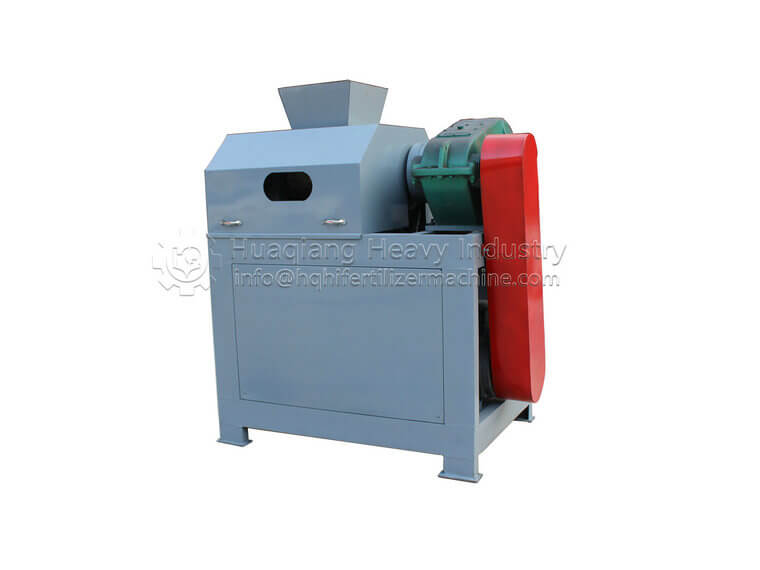
The screw feeding device of the dry powder double roller extrusion granulator is driven by the electromagnetic speed regulating motor, and is rotated by the belt pulley and worm reducer to force the pressed material into the main feeding port. Because of the constant torque characteristic of the electromagnetic speed regulating motor, when the pressing amount of the screw feeder is equal to that of the main machine, the constant feeding pressure can be maintained to stabilize the pellet quality. In the fertilizer production line, if the feeding quantity is too large, the electric overload of the feeding device will occur; if the feeding quantity is too small, it will not form a ball. Therefore, skilled operation technology is an important condition to ensure the normal operation of the pressure ball.
The hydraulic protection device is driven by the hydraulic pump into the hydraulic cylinder to make the piston produce axial displacement. The front connecting head of the piston rod is on the bearing seat to meet the production pressure requirements. When there is too much feeding between the two rollers or metal block, the piston rod of the hydraulic cylinder is pressed and overloaded, the hydraulic pump will stop, the accumulator will buffer the pressure change, the overflow valve will open the oil return, the piston rod displacement will increase the gap between the rollers, so that the hard objects pass through the rollers, the system pressure will be restored to normal, which can protect the rollers from damage. This organic fertilizer granulator can adjust the pressure according to the requirement of the pressure ball density, and the production is flexible.
Equipment advantages and characteristics of chicken manure Organic fertilizer composter
Chicken manure is a relatively high-quality Manure, which contains about 1.63%, 1.54% and 0.085% of pure nitrogen, phosphorus (P2O5) and potassium (K2O). The chicken manure must be decomposed by a humidifying agent before use, and the parasites and their eggs in the chicken manure, as well as some infectious bacteria, can be inactivated and deodorized through the process of decomposition. This requires the use of fermentation and turning equipment. What are the equipment for chicken manure fermentation of Manure in the farm?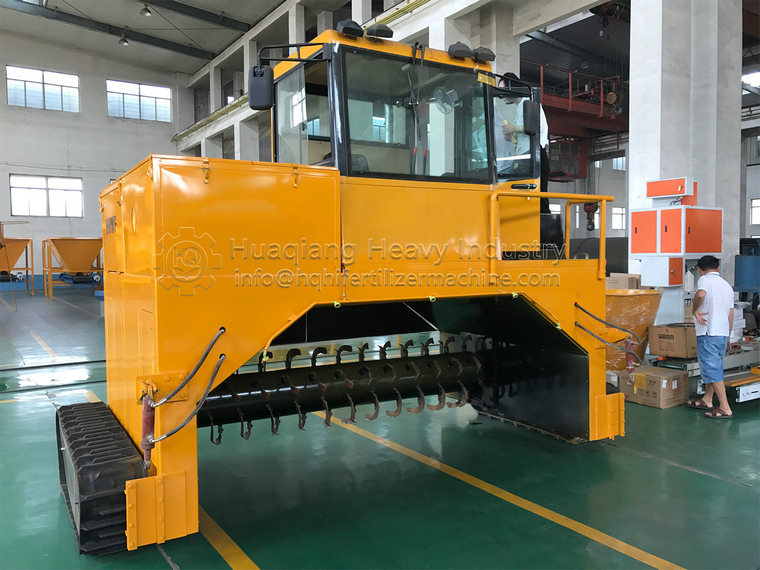
Chicken manure Organic fertilizer composters are widely used in China. For example, trough composters, forklift composters, crawler type composters, walking composters, Manure fermentation tanks, wheel disc composters, chain plate composters are all equipment for chicken manure fermentation in farms. Users of farms can choose corresponding fermentation tipping equipment according to their needs.
Chicken manure Organic fertilizer composter features that it makes full use of space, and the whole machine is solid; The vehicle body is flexible and can easily and conveniently lift the drum as a whole; Adopting advanced engineering machinery transmission technology to ensure no loss between energy conversions; Each component is connected to each other and can be adjusted separately; Under normal operation and careful maintenance, using the machine is zero fault.
Equipment advantages and characteristics of chicken manure Organic fertilizer composter:
1. The ground strip fermentation factory biological Manure mode has obvious advantages of less investment, low energy consumption, fast fertilizer production and large output in mechanical equipment.
The self-propelled Manure dumper is an ideal equipment to use modern technology to transform agricultural wastes, stored feces and organic domestic garbage into high-quality biological Manure.
Main advantage: It saves a lot of civil engineering and manpower and material engineering, making the scalability of fertilizer production more arbitrary.
2. High quality chicken manure Organic fertilizer composter is a dumping equipment used for strip composting, which is mostly used for agricultural livestock manure composting and small-scale municipal sludge treatment projects.
Features: Low price, lowering the investment threshold, suitable for national conditions and public opinion, beneficial for farmers to build factories and actively invest in the comprehensive environmental protection management of stored feces. The overall structure of high-quality chicken manure Organic fertilizer composter is reasonable, the whole machine is rigid, balanced, concise, solid, safe, reliable, easy to operate, and has strong usability in the yard. Except for the coarse frame, the parts are standard parts, which are easy to use and maintain.
Technical features and equipment composition of Organic fertilizer granulator
The organic fertilizer granulator uses the mechanical stirring force of high-speed rotation and the resulting aerodynamic force to make the fine powder continuously realize the mixing, granulation, spheroidization, densification and other processes in the machine, so as to achieve the purpose of granulation.
Technological characteristics of organic fertilizer granulator
Compared with the disk granulator, the granulator has the advantages of high yield, uniform, smooth, high strength and low moisture, and the temperature after forming is about 45 ℃.
After being crushed, the fermented raw materials are mixed with a mixer, so that the water content of the materials is 35% – 40%. After entering the organic fertilizer granulator, the spherical particles can be processed, which are large in water content, large in particle size, small in water content, and small in particle size, which are in direct proportion. It makes use of the characteristics of the organic fertilizer raw materials inlaid and increased with each other under the action, and the particles produced are round, smooth, high in strength, and can also be added Necessary additives, adhesives, etc. 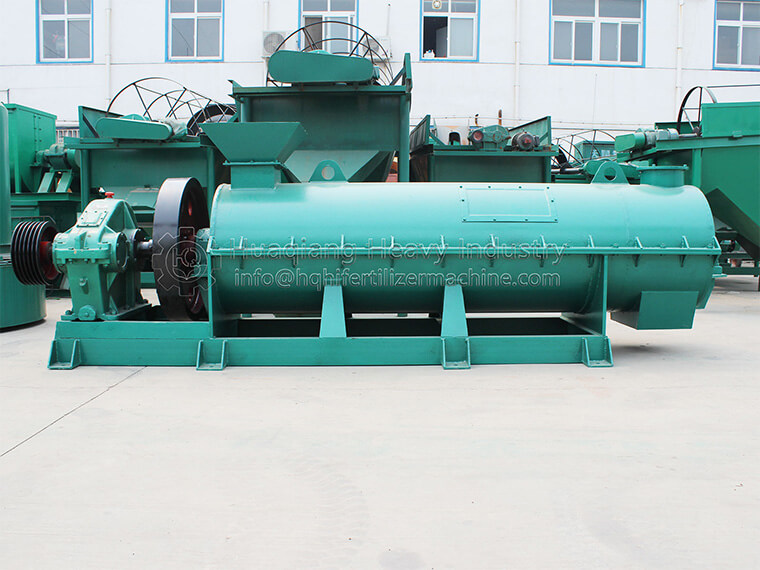
The organic fertilizer machine is composed of motor, transmission, rotor, cylinder and frame
1. High quality motor is adopted, which has the characteristics of strong power, energy saving, reliable quality and overload operation.
2. The internal part of the reducer is made of special materials and processed by special process. It has the characteristics of high bearing capacity, stable operation, durable parts, safe and reliable operation, etc.
3. The rotor is divided into three parts: ① shaft ② teeth ③ stirrer head. The shaft is divided into three sections: ① mixing section ② granulating section ③ polishing section. The main shaft is made of special materials. The stirrer is made of special material, hard and wear-resistant, and can be adjusted in length. The stirrer head is made of alloy steel cutter head.
4. The cylinder is divided into three parts: feed mixing section, granulation section and polishing section.
Solid and durable fermentation self-propelled compost windrow turner
The solid and durable self-propelled fermentation compost windrow turner is used for the fermentation dumper of livestock and poultry manure, sludge waste, sugar factory filter mud, dregs and cake, straw sawdust and other organic wastes. It is widely used in the fermentation and decomposition and water removal operations of sludge waste plant, compound fertilizer plant, organic fertilizer plant, horticultural field and Agaricus bisporus planting plant. It is suitable for aerobic fermentation, with high efficiency, stable operation, firmness and durability, even turning and throwing.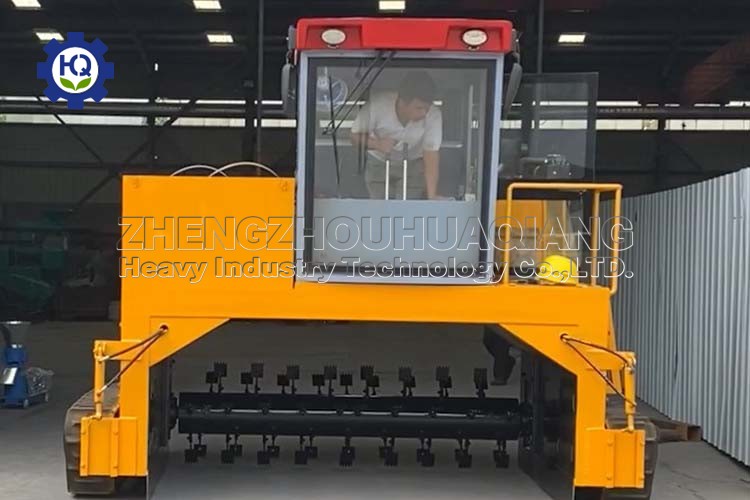
The organic fertilizer compost turning machineis also called crawler type dump truck and wheel type dump truck. The organic fertilizer compost turning machine is a special fermentation equipment in the special equipment for biological organic fertilizer production. The machine adopts the hydraulic assisted crawler walking design, and the tire walking design can move forward, backward and turn, and is driven by one person.Features of robust fermentation self-propelled compost windrow turner:
1. This organic fertilizer machine is used for composting large area organic fertilizer materials. It can stack the organic fertilizer materials into chop shape. The width can be determined according to the working width of the dumper. It can realize rapid composting by turning the dumper back and forth. The advantage of this kind of equipment is that it is not limited by the site, flexible and free;
2. According to the principle of aerobic fermentation, the self-propelled compost windrow turner makes the fermentation bacteria have the space to give full play to its function.
Strong and durable advantages of fermentation self-propelled compost windrow turner:
1. The power balance of the whole machine is suitable, the energy consumption is low, the output is large, the production cost of bio organic fertilizer is reduced, and the price advantage of the finished fertilizer is obvious.
2. The organic fertilizer machine has the obvious advantages of less investment, low consumption, fast fertilizer production and large output.
3. It is an ideal equipment to use modern technology to transform agricultural waste, livestock manure and organic domestic waste into high-quality bio organic fertilizer.
Applicable granulation range of roll extrusion granulator in Organic fertilizer equipment
The Organic fertilizer granulator uses microbial fermentation technology to produce Manure that is deodorized, sterile, highly efficient, and does not burn roots and seedlings from livestock and poultry manure and urban garbage. It is used for grain fields, fruits, vegetables, and flowers, and is suitable for the technical transformation of new plants or existing compound fertilizer plants.
The roller extrusion granulator adopts a non drying room temperature process for production, forming in one go. This equipment has low investment, fast effectiveness, and good economic benefits. The complete equipment layout is compact, scientific and reasonable, and technologically advanced. Energy saving and consumption reduction, no discharge of three wastes, stable operation, reliable operation, and convenient maintenance. Wide adaptability of raw materials, suitable for granulation of various raw materials such as compound fertilizers, pharmaceuticals, chemicals, feed, etc., with high product granulation rate. It can produce compound fertilizers of various concentrations and types (including Manure, inorganic fertilizer, biological fertilizer, magnetized fertilizer, etc.). Especially for the granulation of rare earth, potassium fertilizer, and ammonium bicarbonate series compound fertilizers,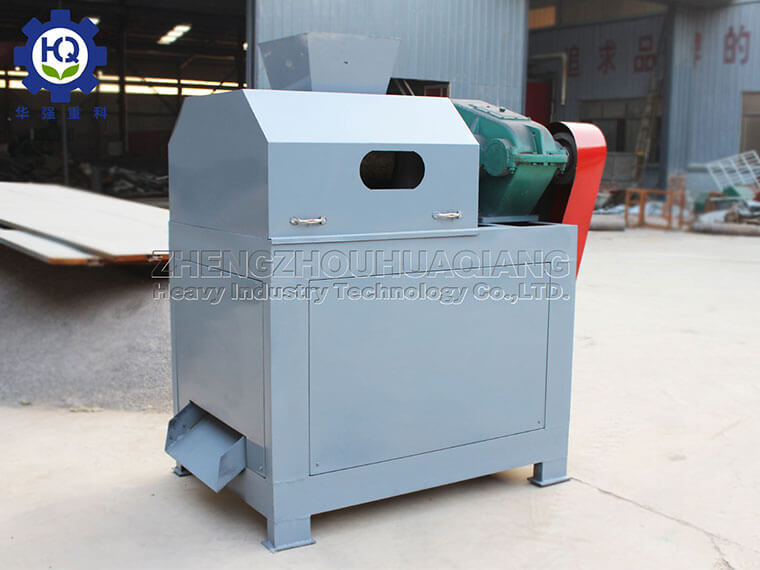
The Organic fertilizer equipment roll extrusion granulator is also suitable for granulation in the following ranges:
1. Granulation of biological Manure with peat, lignite, Manure sludge and straw as raw materials;
2. Granulation of organic compound fertilizer with Manure such as chicken manure as the main raw material;
3. Cookie fertilizer production using soybean cakes and other main raw materials;
4. Granulation of full price feed and mixed feed using corn, beans, grass powder, etc. as raw materials;
5. Granulation of biological feed straw pellets using crop straw as raw material.
The double roll extruding granulator has wide adaptability to raw materials, which can be used to granulate various raw materials such as compound fertilizer, medicine, chemical industry, feed, coal, metallurgy, etc., and can produce compound fertilizers of various concentrations and types (including Manure, inorganic fertilizer, biological fertilizer, magnetized fertilizer, etc.). In particular, the granulation of rare earth, ammonium bicarbonate and ammonium sulfate series compound fertilizer fills the domestic gap and ranks at the leading level in China. It is a promotion project of national environmental protection Appropriate technology. The ball forming rate can reach 86%, adopting a non drying process, granulating at room temperature, forming in one go, with low investment, fast effectiveness, and good economic benefits. Low power, reliable operation, no emissions of three wastes, stable operation, convenient maintenance, reasonable process layout, advanced technology, and low production cost.
Technological process of sheep manure Organic fertilizer production line
Sheep manure organic fertilizer production line is mainly sheep manure, straw, branches, straw production and processing of organic fertilizer. Sheep manure organic fertilizer is a new type of high quality organic fertilizer after special treatment of sheep’s incompletely digested organic matter. It is suitable for geological improvement of alkaline soil and barren land, and has a good effect on increasing crop yield.
Technological process of sheep manure organic fertilizer production line
1. When sheep dung is mixed with appropriate amount of straw powder, the amount of mixing depends on the moisture content of sheep manure. Generally, 45% water content is required for fermentation, that is, the hand is squeezed into a ball, and water can be seen between fingers, but no water is dropped. Once the hand is released, it will disperse. Then, corn flour and bacteria were added. The function of corn flour was to increase sugar content for bacteria fermentation, so that multi-dimensional complex enzyme bacteria quickly took the absolute advantage.
2. Add the mixed material into the mixer for mixing. The mixing must be even and transparent without leaving raw blocks.
3. The mixed ingredients are piled into strips with a width of 1.5m-2m and a height of 0.8m-1m, which are tossed by a compost windrow turner every two days.
4. The compost was heated in 2 days, odorless in 4 days, loose in 7 days, fragrant in 9 days, and composted in 10 days (that is, the temperature on the second day of composting could reach 60 ℃ – 80 ℃, killing E.coli, insect eggs and other diseases and insect pests; on the fourth day, the odor of sheep manure was eliminated; on the seventh day, the compost became loose and dry, covered with white hyphae; on the ninth day, it gave out a flavor of koji; on the tenth day, the compost was fermented and matured).
5. After a little air drying, it can be crushed by a semi wet material crusher, granulated by an organic fertilizer granulator, dried and dehydrated by a dryer, and then screened by a screening machine. The finished organic fertilizer is ready for packaging and storage.
How does Organic fertilizer composter compost and ferment raw materials
Generally, organic compost is fermented for 15-20 days, and such products can only reach the harmless standard. The fermentation process of high quality organic compost usually takes 45-60 days. This is because in the early heating and high temperature stage of composting, plant pathogenic bacteria, insect eggs, weed seeds and other harmful microorganisms will be killed, but the main role of microorganisms in this process is metabolism and reproduction, and only a small amount of metabolites are produced, which are not unstable and easy to be absorbed by plants.
In the later stage of cooling, microorganisms decompose the organic matter and produce a large number of metabolites that are conducive to plant growth and absorption, which takes 45-60 days. Through this process, composting can achieve three goals: harmless; humification; and a large number of microbial metabolites, such as antibiotics, proteins and so on.
Organic fertilizer machine manufacturers tell you that fermentation methods are divided into high temperature compost and ordinary compost according to different raw materials. High temperature compost takes the plant material with high fiber content as the main raw material, and generates a lot of heat through composting fermentation under the condition of aeration. The temperature of compost is very high (50-60 ℃). Therefore, it matures quickly, composts quickly and has high nutritional content.
In the process of high temperature fermentation, pathogens, eggs and weeds can be killed. Common compost is usually mixed with more soil, with low fermentation temperature, slow decomposition process and long composting time. During composting, the chemical composition of nutrient differentiation changed, the ratio of carbon to nitrogen decreased, the mineral nutrients directly absorbed by plants increased, and humus formed.
The horizontal organic fertilizer fermentation tank has the following advantages:
1. High temperature aerobic fermentation, utilizing high-temperature microbial technology, has low energy consumption and operating costs;
2. The equipment occupies a small area and has a high degree of automation. One person can control it to complete the fermentation process;
3. By using biological deodorization equipment to achieve gas emission standards without generating secondary pollution;
4. The main body of the equipment is made of stainless steel special material, which reduces corrosion and has a long service life;
5. The main insulation design and auxiliary heating ensure the normal operation of equipment in low-temperature environments;
6. The treated domestic sludge, kitchen waste and livestock manure are used for processing organic fertilizer to realize resource utilization.